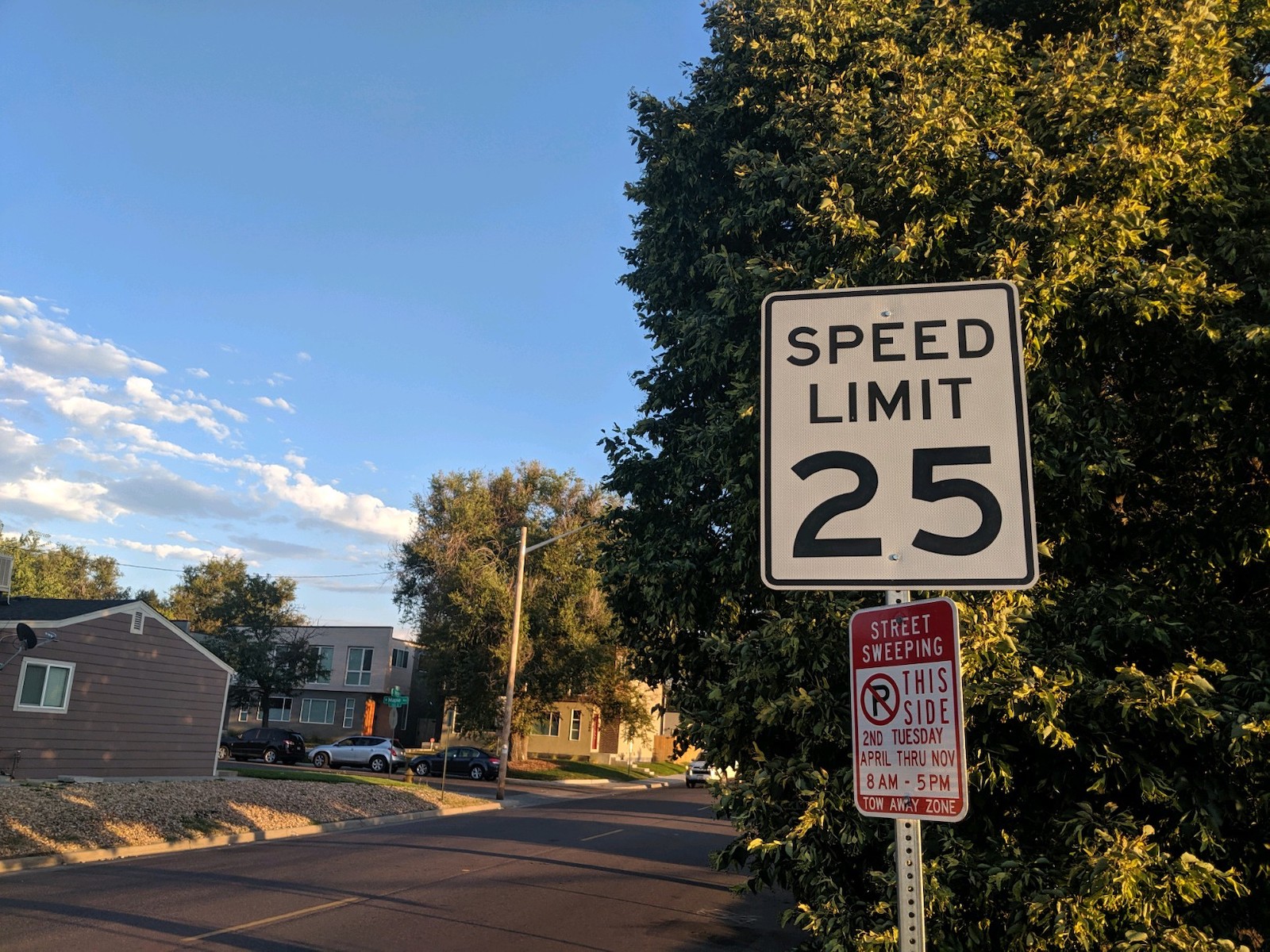The Local newsletter is your free, daily guide to life in Colorado. For locals, by locals.
Even though Denver has vowed to completely eliminate traffic-related deaths and serious injuries by 2030, two cyclists—62-year-old Scott Hendrickson and 37-year-old Alexis Bounds—were killed by vehicles in July, raising the total number of people who have died walking, biking, driving, and riding motorcycles in Denver this year to 55. News of last month’s fatalities sparked unprecedented outcry from Denver’s cycling community and prompted notable voices in the local media to call for change.
The city government, too, was paying attention. Mayor Michael Hancock responded by swiftly announcing a 5 mph reduction in speed limits on several city streets, along with a promise to install high-visibility crosswalks around downtown and more corrals for bike parking on the street. He also announced the city will add more staff members to the city’s police traffic enforcement teams.

The city lowering speed limits is no doubt a victory for street-safety advocates. There are facts to back up this kind of policy: People are simply less likely to die when struck by a car if the car is going slower rather than faster. A 2011 report from the AAA Foundation for Traffic Safety found that if a car strikes a bicyclist or pedestrian going 40 mph, there is a 73 percent chance the victim will die or be severely injured. If the car is going 30 mph, the likelihood of death or severe injury for the victim goes down to 40 percent. At 20 mph, it’s 13 percent.
“Lowering speed limits is important and it’s something that street safety advocates push for,” says Andy Bosselman, editor of Streetsblog Denver (and freelance 5280 contributor). However, speed isn’t everything. As Streetsblog reported, the driver who killed 37-year-old cyclist Alexis Bounds last week was going just 20 mph. He made a right turn and failed to yield to Bounds, who had the right-of-way.
Last week the Denver Streets Partnership, a coalition that advocates for “people-friendly streets,” delivered a list of suggested quick policy changes to city officials. Lowering speed limits is the first suggestion on the list of six, which also includes banning right turns on red and eliminating the buttons pedestrians have to push to get a walk signal, in favor of automatic pedestrian signals. “The number one factor in severe and fatal crashes in Denver is speed,” reads the statement.
Piep van Heuven, chair of the Denver Streets Partnership and policy director of Bicycle Colorado, a local nonprofit advocacy group, says lowering speed limits is “definitely very important” but must be accompanied by two other factors: increased speed enforcement and significant infrastructure changes— “really redesigning the streets so they are, in fact, safer”—in order to be effective.
The city’s “Vision Zero” plan to eliminate traffic deaths by 2030 features several infrastructure changes, including relatively simple fixes that don’t require much construction, such as curb extensions at pedestrian crosswalks to decrease the amount of time it takes to cross the street and slow traffic at intersections.
“That’s the kind of infrastructure street safety activists are pushing for,” Bosselman says. Van Heuven calls the city’s plan “excellent” and in-line with the changes she hopes to see, but adds that “a major disconnect people are seeing is that the plans are there, we’re told that the work is in progress, but we just haven’t seen enough of it on the streets yet. A very fair criticism right now among the mobility community is that the work has not been hitting the streets fast enough.” She says she expects 2020 to be a big year for implementation of the plan.
Traffic-related incidents are occurring throughout the metro area, as well. Over the weekend, a cyclist was killed by a driver in a hit-and-run in Arvada. And in late July, a similar occurrence severely injured a man in Boulder. The cyclist, Andrew “Bernie” Bernstein is currently recovering at an area hospital.
Trang D., an Englewood resident who has been commuting on his bike to Denver’s uptown neighborhood for four years, says he prefers riding in residential streets to bike lanes, because unprotected bike lanes, the kind painted on the street but without plastic buffers, don’t provide enough protection from cars and are often blocked by construction, landscaping crews, and vehicles doing deliveries. “You’re always dodging something,” he says.
When it comes to speed limits, Trang says he doesn’t see that as the most pressing concern. He says the issue he experiences most often is encountering drivers at a stop sign or a stoplight who turn without signaling in front of cyclists attempting to go straight. Trang says he supports the Idaho Stop, a law that would allow cyclists to treat stop signs as yield signs and stop lights as stop signs. In 2018, the Colorado legislature made it legal for municipalities to adopt Idaho Stop laws if they choose to.
For now, Trang’s main strategy is vigilance.
“As a cyclist you get cut off by everybody,” he says. “I know that no one really is looking after me. At least that’s the mindset I go into.”
Editor’s note, 8/20/19: This article was updated with more recent data about the number of fatalities during traffic incidents this year.








